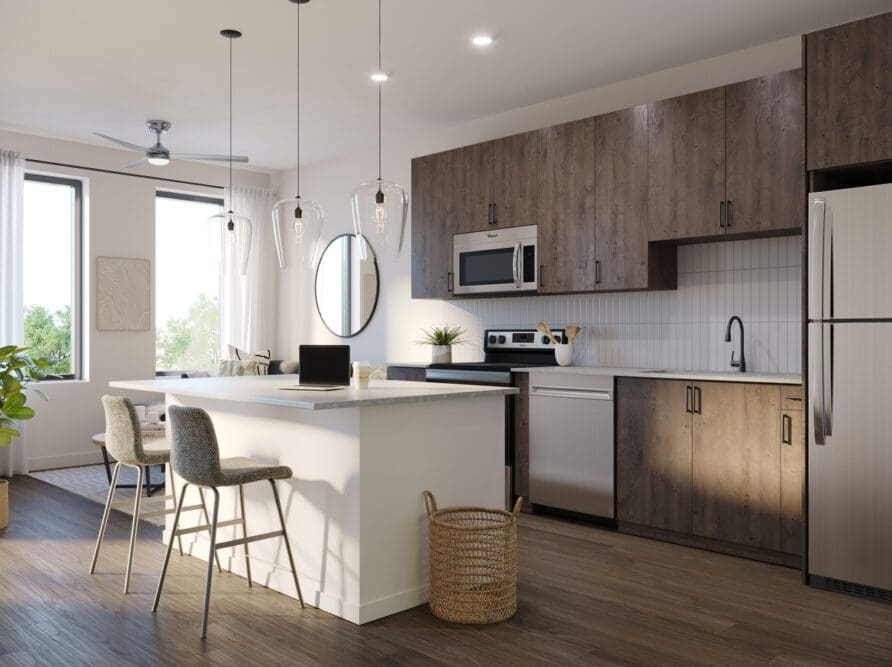Are you an exchange student at OSU and looking for the perfect place to live?
Finding housing in Columbus can be difficult, especially for out-of-state or exchange students who are not very familiar with the area.
At Rambler Columbus, we want to help you understand all of your housing options. That’s why we’ve created this guide to make your housing search simple as an exchange student.

In this article, we answer all of your questions about finding housing as an exchange student near OSU, including:
- Where do OSU students live?
- Which types of housing do OSU students live in?
- How much does it cost to live near OSU?
- What is the best way to find an apartment?
- How do I sign my lease?
Housing Guide for Exchange Students
Where do OSU students live in Columbus?
The most popular areas for exchange students to live include South Campus, North Campus, Central Campus and on-campus housing.
South Campus
South Campus is a popular neighborhood near OSU among undergraduate and graduate students alike. South Campus is located just south of OSU’s campus, directly beneath the Medical Campus. South Campus is defined by Neil Avenue to the west, 11th Avenue to the north, North 4th Street to the east and 5th Avenue to the south.
South Campus offers students proximity to the Wexner Medical Center, the Journalism Building and the Ohio Union.
North Campus
By far the most popular place for OSU undergraduate students to live, North Campus is an energetic area characterized by retail shops, bars, restaurants and student housing.
North Campus is located just North of OSU campus, just across Lane Avenue. North Campus is defined by Perry Street to the west, Lane Avenue to the south, West Patterson Avenue to the north and Summit Street to the east. This is a very walkable neighborhood, almost exclusively home to OSU students.
West Campus offers proximity to the main academic buildings of campus, specifically the Fisher College of Business, The College of Engineering and most science lab buildings.
On Campus
Many undergraduates, especially underclassmen, choose to live on campus in a residence hall, otherwise known as a dorm. Living on campus puts you at the heart of everything – academic buildings, recreation centers, libraries and The Ohio State Union are all within easy reach! Dorm life offers convenient proximity to fellow exchange students, and many residence halls organize community events, making it easier to connect with others.
Central Campus
Another popular neighborhood near OSU is Central Campus. Located just across High Street, this area is a short walk from most parts of campus. This is where you will find Greek houses, fast-food chains, shops and bars.
If you prefer to be close to the busy campus atmosphere, you may want to consider properties in the Central Campus neighborhood.
Amenities and apartments are just as new as most Central Campus properties, the neighborhood provides a similar feel to North Campus but with older homes.
Read More: Where Do OSU Students Live in Columbus?
What types of housing is available for students at Ohio State?
Now that you’re familiar with the residential areas around OSU, let’s explore the various types of housing available for OSU students: residence halls/dorms, student housing apartments, traditional apartments and houses.
Although student housing apartments tend to be the preferred choice among exchange students, it’s crucial to understand all of your available options.
Residence Halls
Residence halls, also known as dorms, are on-campus housing options for OSU students and are owned by the university. You will find that most students living in residence halls are freshmen and sophomores and very few are upperclassmen.
These are typically available on a nine-month term (August through May), offer meal plans and access to on-campus dining halls and come fully furnished.
Student Housing Apartments
Student housing apartments are off-campus housing options built specifically for college students. These are a popular alternative to on-campus dorms that cater to the specific needs of students. This type of housing has become increasingly popular in recent years and is probably the most common type of housing for OSU students. You will find many student housing apartments in North Campus, South Campus and North Campus.
These typically lease on a 12-month basis (although you may be able to find a sublease for a shorter term), offer amenities that are important to students and come fully furnished.
Read Next: sublet article
Traditional Apartments
Traditional apartments are another form of off-campus housing. While less popular than student housing apartments, this type of housing is found in all neighborhoods.
In a traditional apartment setup, the lease agreement is typically provided by the apartment complex. This means that one roommate is accountable for paying the entire rent to the landlord monthly. Roommates will mutually decide on dividing the rent and utility expenses among themselves.
These apartments offer more room and privacy at a comparatively lower cost than other student housing options. However, traditional apartments generally come unfurnished and might offer minimal amenities, if any.
Read Next: Traditional Apartments vs. Student Housing Apartments
Houses
Finally, houses are an off-campus living option for students who do not prefer dorms or apartments.
Students will often rent houses in North Campus and Central Campus, but there are some options in South Campus. Upperclassmen, primarily seniors, and graduate students often choose to rent houses. Houses are a great option for groups who would like to live together.
Some houses will come with WiFi or a dishwasher, but most do not have many amenities. However, they typically come with a yard, which is a great space for hosting or gathering with your housemates. They are typically unfurnished, meaning you need to consider furniture costs.
Read More: What Types of Housing are Available for Students near OSU?
How much does it cost to live in Columbus near OSU?

Most importantly, how much does it cost to live at OSU? While it seems like a straightforward question, the truth is that it varies greatly.
The cost of living near Ohio State ranges based on a variety of factors, including the type of housing, which floor plan you choose, how old your building is, and other features of your space.
The general price range for rental rates near campus can range from under $900 to $2,500 per person, per month. Rent prices in North or Central Campus can be found on either end of this range, while South Campus rates tend to fall on the lower end of that range and on-campus housing falls around the high end.
Read Next: How Much Does it Cost to live near The Ohio State University
How to Begin Your Housing Search
Online Resources
Now that you have an understanding of housing options near OSU, plus how much they cost, it’s time to start searching! Online resources are the most popular way to secure your home and find roommates.
The Ohio State University provides online information regarding off-campus student living. Visit this page on off-campus living resources for helpful tips when you are off-campus or commuting to Ohio State.
Facebook groups, GroupMe chats and other online pages/forums are also extremely popular for exchange students attending OSU.
Facebook groups are very popular for housing and roommate searches. For housing, there are various groups for subleases near OSU, where you will find students looking to sublease their room in a student housing apartment. There are also groups for students who are seeking out a roommate that will be a good match for them. With groups for incoming freshmen, exchange students, people in the same major, and more, Facebook is a great tool for housing and roommate searching.
Some popular, reliable Facebook groups for housing and roommate searching include:
- Ohio State University (OSU) Housing, Sublets & Roommates
- OSU – Ohio State University – Off-campus Housing / Apartment / Sublet
Be sure to watch out for housing scams, as scammers often join these types of online groups, targeting transfer or exchange students.
GroupMe or WhatsApp chats are also very common among exchange students as a means of meeting other exchange students, finding roommates and more.
If you’re leaning towards living in an apartment independently or wish to get detailed information about a specific apartment complex, it’s wise to visit the property’s website before making your decision.
These housing websites commonly feature contact pages, allowing you to connect with their leasing team for further details. Additionally, many student housing apartments provide roommate-matching services, easing the process for individuals who want assistance in finding compatible roommates.
Read More: How to Find a College Roommate at Ohio State
Signing Your Lease
Once you’ve identified the perfect place for you to live near OSU, it’s time to finalize your lease. While this process is generally straightforward, there are a few key points you’ll want to be sure to remember:
Find a guarantor
If you are a full-time student, you will likely need a guarantor to co-sign your lease.Most student housing properties require a guarantor, and many Columbus landlords do not accept undergraduate student tenants unless they have one.
You might be asking… what is a guarantor? A guarantor, often a parent or guardian, co-signs your lease and assumes responsibility for any unpaid rent in case you’re unable to make payments.
Applicants without a credit history in the United States and/or a guarantor might find that the landlord or property manager accepts a prepayment of two installments instead of meeting the credit/guarantor criteria. However, this is subject to the specific policy of each apartment complex. It’s best to inquire with your leasing team about their policy regarding this.
Prepare your documents
Before finalizing your lease, the landlord will conduct a credit check, requiring you and your guarantor to gather bank account statements, pay stubs, and Social Security numbers.
For applicants who are citizens of another country, additional documentation is required, such as a passport, the relevant INS document validating their stay in the United States, and an I-20 confirming student status and enrollment proof. The landlord or property manager might request photocopies of these INS documents, international passport, and/or visa.
If you’re unable to provide immediate proof of enrollment during the application, you might still be approved under the condition that you’ll submit proof as soon as it’s available. To confirm these specifics, it’s essential to speak with the leasing team.
Carefully read over your lease agreement
Typically spanning around 40 pages, a student lease might seem extensive, but comprehending each section is necessary. Since a lease is a legally binding agreement, understanding your responsibilities is important.
You should familiarize yourself with the specific terms outlined in your lease. Pay careful attention to:
- Deadlines and fees
- Rental amount and due date
- Pet policy
- Rental insurance
- Length of your lease
- Lease-breaking policy
- Sublease policy
Sign!
After you fully understand the terms of your lease, it’s time to sign. Once the lease is signed by you and your guarantor, and your credit check is passed, your lease is ready for approval. Congratulations!
 guide-housing-osu-exchange-student
guide-housing-osu-exchange-student
We hope that this article helped you understand how to find housing near Ohio State as an exchange student.
Read about the top apartments near campus that you should consider: 7 Best Student Apartments in Columbus, Ohio near OSU
If you have any further questions or you’re interested in living at Rambler Columbus, contact our leasing team, who are happy to help in your search for housing.



